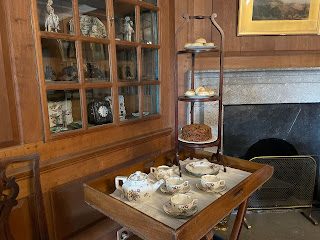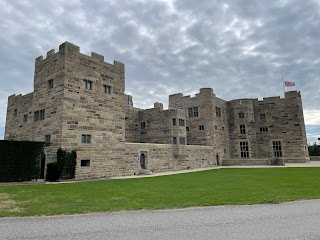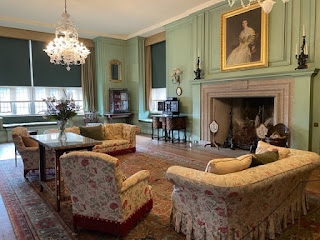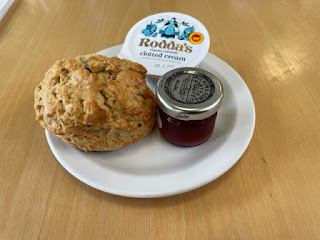Which National Trust property has been the biggest surprise for you when you first set eyes on it in real life? There are loads of contenders - the quirkiness of A la Ronde or the romantic beauty of St Michael's Mount are two for starters.
For me, though, I'm going with Castle Drogo in Devon as my surprise package. Castle Drogo's claim to fame is that it was the last castle to be built in England and when you see it in photos it ticks all the castle boxes: big, solid, made of granite, has a castellated roof for firing arrows at pesky invaders.
But when you finally see it in front of you, you realise it's a very modern take on a castle. It was built between 1910 and 1925, so the modern look shouldn't be a surprise. But it's like someone has taken a normal castle and then gone at it with a chainsaw to smooth out the usual edges and give it a square and boxy shape:
Admittedly, it looks less boxy when you get up close to it. But then it appears almost as if half the castle has sunk into the ground and you're only seeing the top section. It messes with your mind a lot, put it that way:
So, the question is: WHY? Let me try and explain:
Julius Drewe makes his fortune and retires at 33!
Julius Drewe was a grocer by trade. His mother was a member of the family who owned Peek, Frean & Company, inventors of the Bourbon and Garibaldi biscuits. Julius set up Home and Colonial Stores, which became phenomenally successful - by 1903, it had 500 stores. By then, however, Julius had retired, at the venerable age of 33. There is a family legend that he turned down the offer of a peerage for £100,000 on principle that honours shouldn't be bought. Instead, he decided to plough some of his money into something that he decided could be bought: an ancestral estate dating back to Norman times.
Julius finds his noble ancestor, Drogo de Teigne!
A genealogist had informed Julius that he was possibly connected to a Norman baron known as Drue or Drogo de Teigne. The village of Drewsteignton on the edge of Dartmoor was named after him and so that is where Julius decided to buy some land, build his castle and claim the ancestral heritage that was rightfully (probably) his.
Julius commissions Edwin Lutyens to design Castle Drogo!
The celebrated architect Edwin Lutyens completed over 400 projects during his career. He is most famous for the Cenotaph in London and Rashtrapati Bhavan (formerly Viceroy's House) in New Delhi, as well as a whole host of other houses, offices, war memorials and churches. In 1910, he was well into his stride, having already transformed a ruined fort into a holiday home on Lindisfarne. Julius commissioned him to build Castle Drogo with a large budget and work got underway.
Edwin Lutyens designs everything!
What is astonishing about Lutyens is that he designed everything, even the latches on cabinets in the kitchens (he loved kitchens apparently). How he found the time for such detail when he was simultaneously out in India trying to architect an entire city is beyond me.
Julius and Edwin ensure the castle is comfortable!
Like the outside, the interiors of Castle Drogo are strikingly old-modern. The walls are granite and look austere and cold but the castle always offered central heating and other modern conveniences.
You can see how very liveable the whole building must have been:
Castle Drogo passes to the National Trust
Julius insisted that Castle Drogo had a flat roof and this caused leakage problems from the get-go. Eventually, it all just got too much for one family to manage; the guidebook tells how Anthony Drewe, grandson of Julius, wrote a letter to the National Trust to ask if they'd be interested in taking on the property. The letter contained just one sentence - "I write to enquire whether the National Trust would be interested in acquiring this house, together with the Teign Gorge stretching over to Fingle Bridge?" - and in 1974, the castle and 600 acres of land were given to the National Trust.
 |
| I was pleased to see some 'stunt scones' doing their thing |
The Castle Drogo Scone
It must be incredibly difficult to run the Food & Beverage operation at the National Trust. If you take just today as an example: I started out in Heddon Valley on the North Devon coast in the morning. It was a truly beautiful spot but the cafeteria was really basic - the woman had to put the kettle on to make me a cup of tea. There were no scones but it didn't really matter; they had flapjacks and brownies to keep the walkers happy.
Castle Drogo, on the other hand, is at the opposite end of the F&B spectrum. The visitor centre is big and visitor-centrey, with a large cafeteria serving all sorts of food and drinks. This prompted me to throw caution to the winds and wander round the castle first - I NEVER do this as I'm always too worried that all the scones will be eaten by a swarm of locusts who followed me into the car park.
Castle Drogo was the fourth and final stop on my mini Devon road trip: as well as Heddon Valley, I'd also been to Lundy, which had been lovely but no scones, and Lorna Doone Valley, which had delivered a scone but it hadn't quite been a five-star performer.
So I was overjoyed when the Castle Drogo scone turned out to be excellent. It was fresh and tasty and a good size.
Only a few final scones to go!
Castle Drogo: 5 out of 5
Scone: 5 out of 5
Oscar-worthy performance of the stunt scones: 5 out of 5






No comments:
Post a Comment